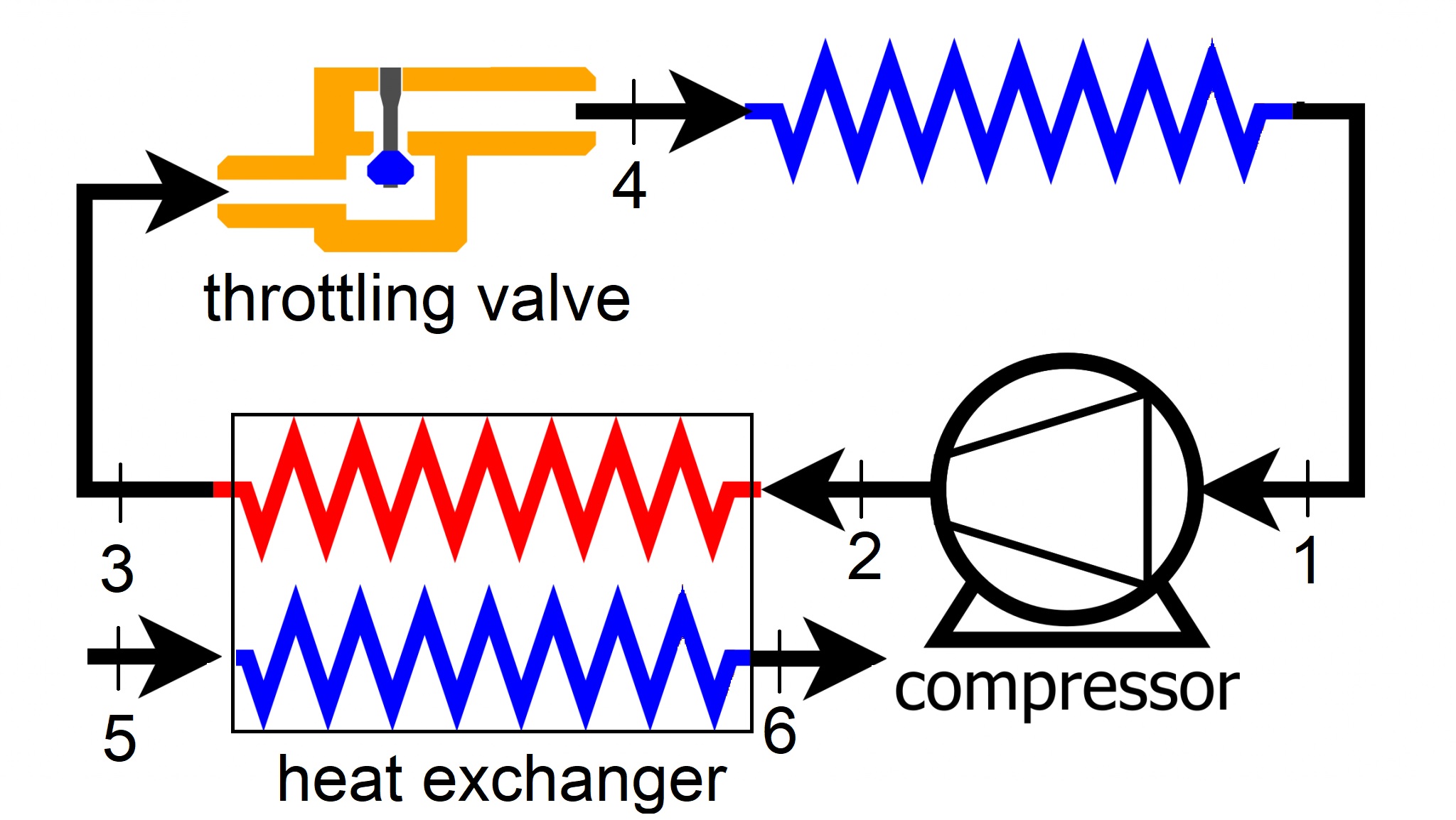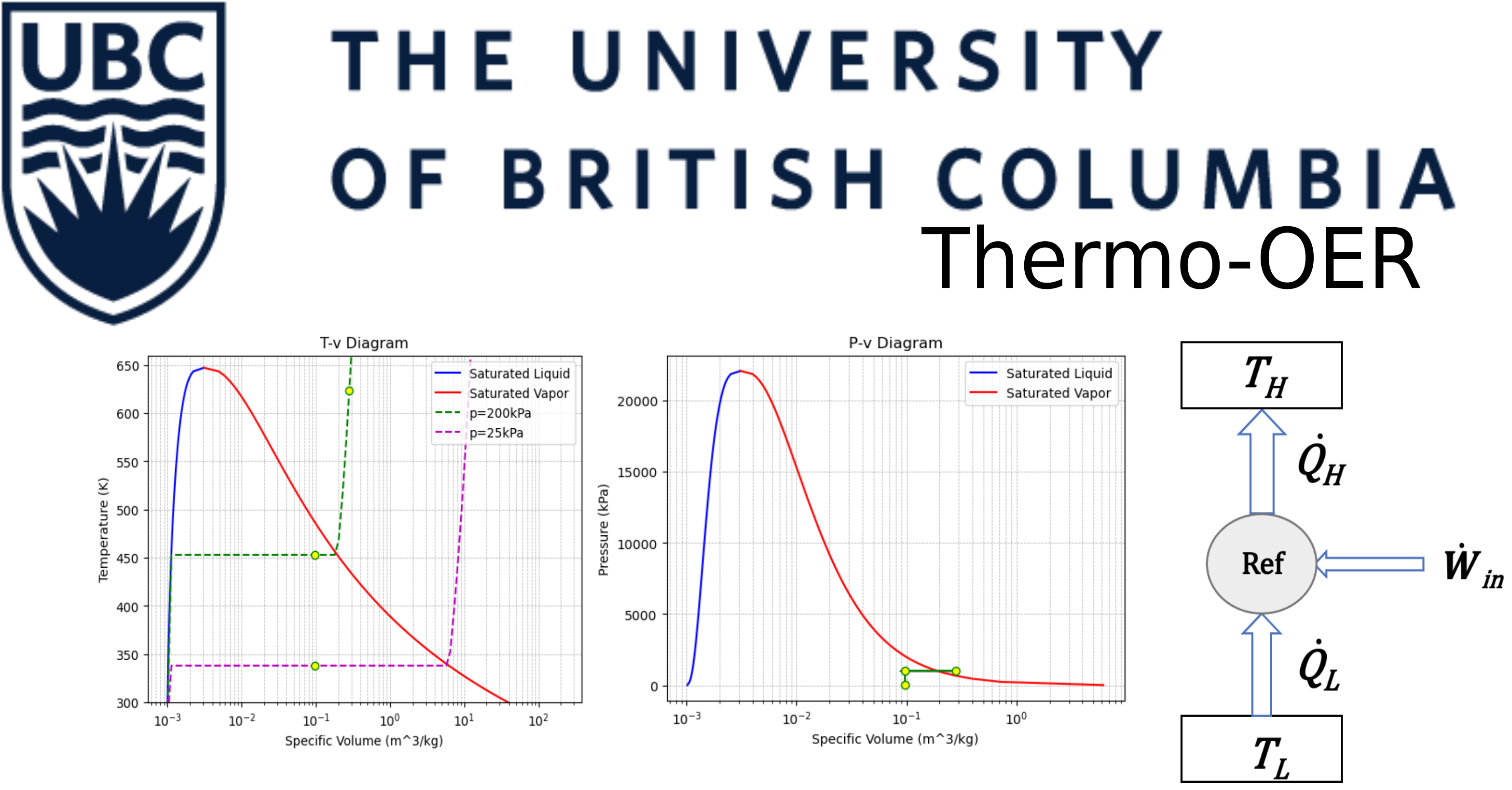5.7 Refrigeration cycle: Water flow-rate#
Consider a refrigeration cycle using R134-a as the working fluid. The refrigerant absorbs heat at \(-20 ^{\circ} C\) during evaporation and enters the compressor as a saturated vapor. The compressor then pressurizes R134-a until its temperature increases to \(120 ^{\circ} C\). The refrigerant is then cooled down to a saturated liquid at \(40 ^{\circ} C\) at constant pressure in a heat exchanger before entering a throttling valve. The refrigerant is throttled to \(-20 ^{\circ} C\) then enters the evaporator. Assuming the refrigerant rejects heat to pressurized water in the heat exchanger, heating the water from room temperature to saturated vapor at \(110 ^{\circ} C\), calculate the amount of water per kg of R134a to support cooling power in the heat exhanger.

Solution Approach#
Based on the first law of thermodynamics, for the heat exchanger
\(Q+\dot m_ih_i=\dot m_eh_e\)
Assuming no heat losses from the heat exchanger,
\(\dot m_5h_5+\dot m_2h_2=\dot m_3h_3+\dot m_6h_6\)
given
\(\dot m_5=\dot m_6=\dot m_{water}\)
and
\(\dot m_2=\dot m_3=\dot m_{R134a}\)
water flow-rate per \(1\:kg/s\) of \(R134a\) flow-rate would be
\(\dot m_{water}=(h_2-h_3)/(h_6-h_5)\)
from question 5 of this chapter
## import the libraries we'll need
import CoolProp.CoolProp as CP
# define variables
fluid = "R134A" # define the fluid or material of interest
T_3 = 40 + 273.15 #state #3 temperature in K
h_3 = CP.PropsSI("H", "T", T_3, "Q", 0, fluid)/1000 # enthalpy of the refrigerant at state #3 in kJ/kg
h_4 = h_3 #constant enthalpy through a throttling valve
T_4 = -20 + 273.15 #temperature of refrigerant at state #4 in K
P_4 = CP.PropsSI("P", "T", T_4, "Q", 1, fluid) # pressure of the refrigerant at state #1 in Pa (quality is set to 1 as the pressure keeps constant in sat region)
T_1 = T_4 #temperature at state #1 in K
h_1 = CP.PropsSI("H", "T", T_1, "Q", 1, fluid)/1000 # enthalpy of the refrigerant at state #1 in kJ/kg
T_2 = 120 + 273.15 #temperature at state #2 in K
P_3 = CP.PropsSI("P", "T", T_3, "Q", 0, fluid) # pressure of the refrigerant at state #3 in Pa
P_2 = P_3 # pressure of the refrigerant at state #2 in Pa
h_2 = CP.PropsSI("H", "T", T_2, "P", P_2, fluid)/1000 # enthalpy of the refrigerant at state #2 in kJ/kg
#for the water side
fluid = "water"
T_6 = 110 + 273.15 #temperature of water at heat exchanger exit in K
T_5 = 25 + 273.15 #temperature of water at heat exchanger inlet in K
h_6 = CP.PropsSI("H", "T", T_6, "Q", 1, fluid)/1000 #enthalpy of water at heat exchanger exit in kJ/kg
P_6 = CP.PropsSI("P", "T", T_6, "Q", 1, fluid) #pressure of water at heat exchanger exit in Pa
P_5 = P_6 #pressure of water at heat exchanger inlet in Pa assuming constant pressure heating
h_5 = CP.PropsSI("H", "T", T_5, "P", P_5, fluid)/1000 #enthalpy of water at heat exchanger exit in kJ/kg
m_water = (h_2 - h_3) / (h_6 - h_5)
print('The required water flow-rate to support cooling per kg/s of R134a:', f"{m_water:.1f}", 'kg/s')
The required water flow-rate to support cooling per kg/s of R134a: 0.1 kg/s
